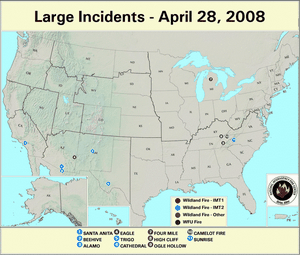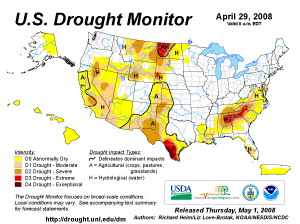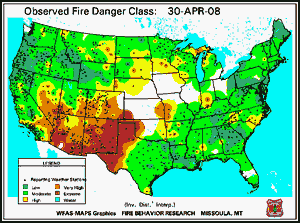Wildfire activity continued in the southern Plains into April, with fires in Oklahoma, Nebraska, west Texas, New Mexico and Arizona. Additional fires flared in the central Gulf states and the central Appalachian mountains. The southern Plains and southwest continued to be a hotspot for fire activity into the middle of the month, and additional fires occurred at Friday Creek, Alaska, Hughett, Oregon and the Florida Panhandle. By the end of April the majority of fires in the southern Plains states had been contained, while new fires developed in the southwest and the mountains of eastern Tennessee and western North Carolina.
Long–term moisture deficits have continued to maintain moderate to severe drought conditions across large portions of the western and southeastern U.S. in late April.
As of May 7th, there have been over 21,000 wildland fires and more than 1.3 million acres burned so far in 2008, according to the National Interagency Fire Center (NIFC). The year 2008 ranks second behind 2006 in quanity of acreage burnt to date, and is nearly twice the 2001–2008 average.
The persistence of moderate–to–severe drought conditions across parts of the West have aided in developing a region of extreme fire potential across parts of the Southwest, according to the U.S. Forest Service (USFS) Experimental Fire Potential Index.
At the end of April, high to very high fire danger was observed across parts of Arizona, New Mexico, Nevada, and west Texas. In addition, moderate to high fire danger existed across the Atlantic states from northeastern Georgia to southern Virgina.
| Year–To–Date Totals as of May 7th | Nationwide Number of Fires | Nationwide Number of Acres Burned |
|---|---|---|
| 5/07/2008 | 21,121 | 1,342,963 |
| 5/07/2007 | 26,410 | 555,258 |
| 5/07/2006 | 37,383 | 2,328,258 |
| 5/07/2005 | 20,801 | 292,309 |
| 5/07/2004 | 26,177 | 388,676 |
| 5/07/2003 | 15,413 | 353,524 |
| 5/07/2002 | 25,156 | 489,759 |
| 5/07/2001 | 25,644 | 501,518 |
| 5/07/2000 | 31,415 | 791,236 |
| 6–yr average (2003 – 2007) |
26,378 | 981,584 |
| 9–yr average (2000 – 2008) |
25,935 | 774,275 |
Dead fuel moisture levels continued to dry out across the Southwest during April. The 10–hour fuel moisture levels on April 28th were exceptionally dry throughout much of the western U.S., with the Southwest being extremely dry.
Medium to larger fuels (i.e., the April 28th 100–hr and April 28th 1000–hr fuel moistures) were also very dry, with the driest fuel conditions extending from Southern California up through Nevada and across to west Texas.
The Keetch–Byram Drought Index (KBDI), a widely used drought index for fire risk, continued to have the largest potential for wildland fire activity in the contiguous U.S. across portions of the Great Basin, southwest Texas and New Mexico, as well as over portions of south Florida.
 NOAA's National Centers for Environmental Information
NOAA's National Centers for Environmental Information


